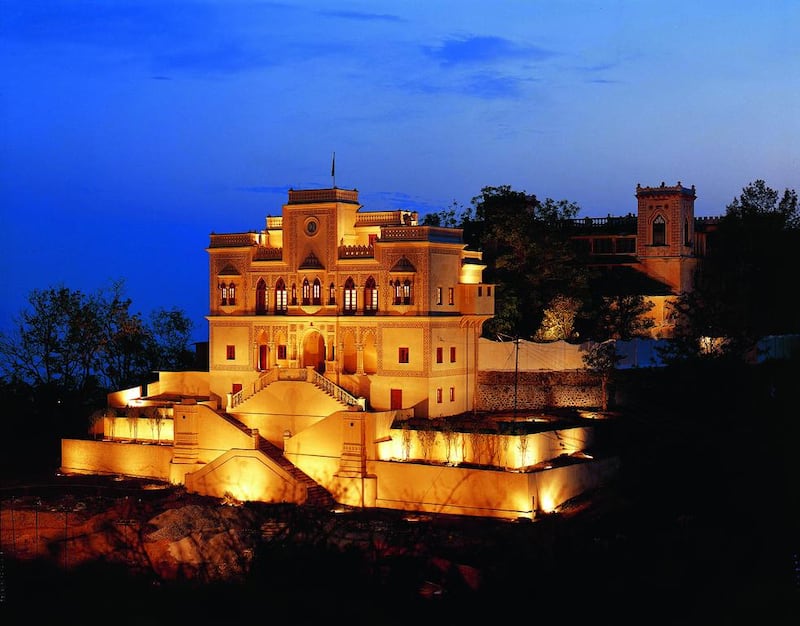The driver asks me how I am feeling three times during my 50-minute journey to Ananda in the Himalayas. We are circling up the foothills from Dehradun, a hill station and the capital of the north Indian state of Uttarakhand. Each time, cheered by the sunshine, greenery and sharp outline of the mountains against the sky, I reply that I’m fine and wonder why he’s so concerned. By the third query, I know why he’s asking.
It’s almost fitting that so many guests arrive at Ananda a little carsick from the trip. I imagine most recover as quickly as I do, though, because the time that lays before them is designed to be entirely restorative. Ananda means bliss and contentment in Sanskrit, after all.
The setting
Located about 30 minutes from the holy city of Rishikesh, Ananda is on a 100-acre property within Uttarakhand’s Tehri Garhwal district. The vibe at this hilltop spot – which boasts sweeping views of the Ganges, the surrounding mountain range and the Rishikesh below – is decidedly high-end Zen.
The heart of the property, once home to the maharaja of Narendra Nagar, is the Viceregal Palace, built in 1910 for a visit from the Viceroy of India. The property was restored and expanded upon in 2000, becoming India’s first destination spa.
Coming from our UAE desert setting, I’m delighted at being surrounded by a forest of lush green sal trees. The original palace, which houses a meditation room, library and billiards hall, sits uphill from the main guest rooms, three private villas, spa and restaurant. Golf carts are readily available for guests who opt out of walking up the sharp incline to morning hatha yoga sessions and afternoon guided meditations. There is a communal pool adjacent to the spa; Ananda also has a running track and a six-hole golf course, with turf imported from the United States.
My room, decorated in soothing shades of yellow, cream and gold, has gorgeous teak furniture and all the amenities that one might expect from a high-end getaway: a pillow menu, television and DVD player, minibar, coffee and tea fixings, a spacious separate shower and a gorgeous sunken bathtub beside a large window with a clear view of the mountains. The porter warns me to lock my door, because of the ever-mischievous monkeys playing outside.
The philosophy
Each day there are two morning hatha yoga classes, an evening meditation session and an evening lecture based on the Vedanta, the classic Hindu texts. I attend the intermediate morning yoga classes and find them just as hatha sessions are supposed to be: basic, only briefly and slightly challenging, grounding and calming.
The Ananda experience is centred on the five elements of Ayurveda – space, air, fire, water and earth – and dosha, the three-vital-energies theory. An Ayurvedic doctor takes me through a survey and determines that I have a vata dosha: heavy on the air and water, light on the earth of a kapha and the ether and fire of a pitta, although like all people, I possess all three. Vatas have active minds and tend to be anxious and more high-strung; the aim of finding this is out, the doctor explains, is that I can then alter my lifestyle to incorporate calming foods and activities. He tells me to avoid raw food and rest my mind regularly with meditation – resisting the urge to watch a TV programme or read.
The guests
Prince Charles and Camilla, Duchess of Cornwall, Ricky Martin and Oprah Winfrey have all been guests here in Ananda’s gorgeous private villas in the last six months. During the week that I spend at Ananda, the spa hosts Ben Haggerty, also known as Macklemore (of Macklemore and Ryan Lewis), who is due to perform at Du Arena in Abu Dhabi later this month and is fresh off winning four Grammy Awards.
A group of four women in their 50s from Finland are spending two weeks devoting themselves to yoga, while a couple of friends from Almaty, Kazakhstan, spend a week away from their children, one of them attempting to pull herself together in the midst of a divorce. A wealthy couple from Russia, who are yoga enthusiasts, jet out to Agra on a private plane.
At many times during the week, I find myself wishing that guests were required to relinquish their mobile devices at check-in. Although we’re told to turn our phones off in the spa, and during yoga and meditation, there’s one woman who steadfastly refuses. We’re subjected to the sound of repeated, loud calls as she tries to locate her husband – who seems to always be anywhere but at her side – for days in a row.
The treatments
The spa is massive, at 24,000 square feet, and where most have flute music piped in through a speaker system, much of the time there actually is a flautist performing cross-legged in one of the foyers. The spa is a world away from the modern versions found in the UAE: gorgeous and authentic, decorated in dark wood and green marble.
But the most important thing is that treatments here, both Ayurvedic and those with a more international flavour, are what set Ananda apart. It’s all too common to visit a luxury resort in the Gulf and pay upwards of Dh700 for a so-so massage – the ultimate disappointment considering the expense, the expectations and the promises. Every single treatment I had at Ananda, most of them available à la carte for less than US$100 (Dh367), was top-notch. On the Ayurvedic side, the abhyanga, or four-hands massage, was offered by two talented therapists and, like all the Ayurvedic treatments, is punctuated with lovely little extras: a beautiful prayer sung at the beginning, a gentle, warm footbath and a tinkling bell rung to signal the end.
My favourite of the week, the “fusion” massage, was transformative – and prompts me into one of the most relaxed states I’ve ever been in. My male therapist Sandeep is a magician: he uses long, slow strokes, yet manages to work out knots as he goes, following with gentle sweeping and tapping with hot poultices filled with a mixture of black pepper, cardamom and ginger.
The food
I eat mostly from the wellness menu tailored to my dosha. Unlike other spas, the kitchen is utterly flexible: one morning, when our breakfast proves too small, the waiter happily brings us an extra plate of banana pancakes. I love the fresh, vibrant juices on offer, both vegetable- and fruit-based, and the evening treats, which one night include an outdoor buffet offering Indian street food, and another an addictive banana crumble.
On the Vata plan, my meals were preceded with an elixir of rock salt, watermelon and lemon as well as a cup of warm water in which to dissolve a mixture of spices – turmeric, ginger – combined to promote digestion. The food is delicious – oatmeal and parathas for breakfast, curries and roti for lunch – and all impeccably prepared. After five days, I had dropped the most effortless kilogram of my life.
The excursions
I choose to go on two excursions offered by the spa and both are well worth the effort. The first is the Ganga aarti ceremony, a Hindu fire-offering ritual that takes place daily at sundown on the banks of the Ganges in Rishikesh, about a 30-minute drive from the spa. After a short boat ride to the other side of the river and a quick poke around, I settle in for 90 minutes of singing by residents of the local ashrams, many of them young boys clad in scarlet robes, as the sun sets. The ceremony ends with the lighting of lamps, the entire ritual designed to drive darkness away. Although I can’t understand the chanting/singing, being surrounded by all those voices is infectious, and I feel the joy well into the next day.
The second trip presents an intermediate-level challenge: a two-and-a-half-hour trek up the mountains to the Kunjapuri Temple. The journey up to 1,645 metres was well worth the effort, not only to nip inside the small temple space, lit with oil lamps and filled with the smell of burning incense, but also to gaze off at the snow-capped Greater Himalayan peaks in the distance.
The experience
Every time I cross paths with a staff member, I’m greeted with a nod of the head and a “namaskar”. The waiters are fast, intuitive, friendly and accommodating, willing to banter if that’s what guests desire, and are particularly attentive when I dine alone. One classy touch: they kneel down to your level while taking the order, so I never have to crane my neck to see them.
I get a nasty shock when, craving a bath on one of the coldest nights, my room has no hot water. Staff deliver a lovely gift of incense and essential oil the next day as an apology, but the disappointing truth is that the water is never hot enough for the rest of the week and the lovely sunken tub goes largely unused. Although on extra chilly nights staff deliver hot water bottles, the bottom line is if you don’t like being chilly and enjoy the outdoors, visit during the warmer months.
The dramatic transformation that I undergo from arrival to departure proves there is something special to Ananda, even if all you want is a place to relax. At the beginning of the week I was wired, tired, worried and anxious, unable to follow the story of the book I was reading without my mind pinging off wildly. But I leave calm, centred and with new perspective, a kalava, or sacred Hindu red thread, that remains tied around my wrist as a daily reminder that it’s up to me to try to stay that way.
amcqueen@thenational.ae





